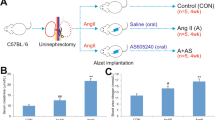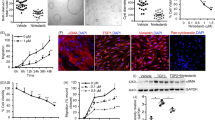Abstract
Renal fibrosis is an important factor for end-stage renal failure. However, only few therapeutic options for its treatment are established. Zaprinast, a phosphodiesterase 5 inhibitor, and serelaxin, the recombinant form of the naturally occurring hormone relaxin, are differently acting modulators of cyclic guanosine monophosphate (cGMP) signaling. Both agents enhance cGMP availability in kidney tissue. These substances alone or in combination might interfere with the development of kidney fibrosis. Therefore, we compared the effects of combination therapy with the effects of monotherapy on renal fibrosis. Renal fibrosis was induced by unilateral ureteral obstruction (UUO) for 7 days in wild-type (WT) and cGKI knockout (KO) mice. Renal antifibrotic effects were assessed after 7 days. In WT, zaprinast and the combination of zaprinast and serelaxin significantly reduced renal interstitial fibrosis assessed by α-SMA, fibronectin, collagen1A1, and gelatinases (MMP2 and MMP9). Intriguingly in cGKI-KO, mRNA and protein expression of fibronectin and collagen1A1 were reduced by zaprinast, in contrast to serelaxin. Gelatinases are not regulated by zaprinast. Although both substances showed similar antifibrotic properties in WT, they distinguished in their effect mechanisms. In contrast to serelaxin which acts both on Smad2 and Erk1, zaprinast did not significantly diminish Erk1/2 phosphorylation. Interestingly, the combination of serelaxin/zaprinast achieved no additive antifibrotic effects compared to the monotherapy. Due to antifibrotic effects of zaprinast in cGKI-KO, we hypothesize that additional cGKI-independent mechanisms are supposed for antifibrotic signaling of zaprinast.







Similar content being viewed by others
References
Bathgate RA, Halls ML, van der Westhuizen ET, Callander GE, Kocan M, Summers RJ (2013) Relaxin family peptides and their receptors. Physiol Rev 93:405–480. doi:10.1152/physrev.00001.2012
Bender AT, Beavo JA (2006) Cyclic nucleotide phosphodiesterases: molecular regulation to clinical use. Pharmacol Rev 58:488–520. doi:10.1124/pr.58.3.5
Buglioni A, Burnett JC Jr (2016) New pharmacological strategies to increase cGMP. Annu Rev Med 67:229–243. doi:10.1146/annurev-med-052914-091923
Chen Y, Blom IE, Sa S, Goldschmeding R, Abraham DJ, Leask A (2002) CTGF expression in mesangial cells: involvement of SMADs MAP kinase, and PKC. Kidney Int 62:1149–1159. doi:10.1111/j.1523-1755.2002.kid567.x
Chevalier RL, Forbes MS, Thornhill BA (2009) Ureteral obstruction as a model of renal interstitial fibrosis and obstructive nephropathy. Kidney Int 75:1145–1152. doi:10.1038/ki.2009.86
Chow BS, Chew EG, Zhao C, Bathgate RA, Hewitson TD, Samuel CS (2012) Relaxin signals through a RXFP1-pERK-nNOS-NO-cGMP-dependent pathway to up-regulate matrix metalloproteinases: the additional involvement of iNOS. PLoSOne 7:e42714. doi:10.1371/journal.pone.0042714
Cui W et al (2014) Increasing cGMP-dependent protein kinase activity attenuates unilateral ureteral obstruction-induced renal fibrosis. Am J Physiol Renal Physiol 306:F996–1007. doi:10.1152/ajprenal.00657.2013
D'Andrea MR, Qiu Y, Haynes-Johnson D, Bhattacharjee S, Kraft P, Lundeen S (2005) Expression of PDE11A in normal and malignant human tissues. J Histochem Cytochem 53:895–903. doi:10.1369/jhc.5A6625.2005
Francis SH, Corbin JD (1994) Structure and function of cyclic nucleotide-dependent protein kinases. Annu Rev Physiol 56:237–272. doi:10.1146/annurev.ph.56.030194.001321
Francis SH, Turko IV, Corbin JD (2001) Cyclic nucleotide phosphodiesterases: relating structure and function. Prog Nucleic Acid Res Mol Biol 65:1–52
Giannandrea M, Parks WC (2014) Diverse functions of matrix metalloproteinases during fibrosis. Dis Model Mech 7:193–203. doi:10.1242/dmm.012062
Guan Z, Miller SB, Greenwald JE (1995) Zaprinast accelerates recovery from established acute renal failure in the rat. Kidney Int 47:1569–1575. doi:10.1038/ki.1995.220
Halls ML, Bathgate RA, Sutton SW, Dschietzig TB, Summers RJ (2015) International Union of Basic and Clinical Pharmacology. XCV. Recent advances in the understanding of the pharmacology and biological roles of relaxin family peptide receptors 1-4, the receptors for relaxin family peptides. Pharmacol Rev 67:389–440. doi:10.1124/pr.114.009472
Hohenstein B, Daniel C, Wittmann S, Hugo C (2008) PDE-5 inhibition impedes TSP-1 expression, TGF-β activation and matrix accumulation in experimental glomerulonephritis. Nephrology Dialysis Transplantation 23:3427–3436. doi:10.1093/ndt/gfn319
Ibrahim MA, Satoh N, Ueda S (2003) Possible impact of nitric oxide on the antihypertensive effect of captopril and zaprinast. Adv Ther 20:143–148. doi:10.1007/BF02850201
Kiss T et al (2014) Novel mechanisms of sildenafil in pulmonary hypertension involving cytokines/chemokines MAP kinases and Akt. PLoS One 9:e104890. doi:10.1371/journal.pone.0104890
Kulkarni SK, Patil CS (2004) Phosphodiesterase 5 enzyme and its inhibitors: update on pharmacological and therapeutical aspects. Methods Find Exp Clin Pharmacol 26:789–799. doi:10.1358/mf.2004.26.10.872561
López-De León A, Rojkind M (1985) A simple micromethod for collagen and total protein determination in formalin-fixed paraffin-embedded sections. Journal of Histochemistry & Cytochemistry 33:737–743. doi:10.1177/33.8.2410480
Lowry OH, Rosebrough NJ, Farr AL, Randall RJ (1951) Protein measurement with the Folin phenol reagent. J Biol Chem 193:265–275
Metra M et al (2013) Effect of serelaxin on cardiac, renal, and hepatic biomarkers in the relaxin in acute heart failure (RELAX-AHF) development program: correlation with outcomes. J Am Coll Cardiol 61:196–206. doi:10.1016/j.jacc.2012.11.005
Neild GH (2016) Life expectancy with chronic kidney disease: an educational review. Pediatr Nephrol:1–6. doi:10.1007/s00467-016-3383-8
Novartis (2017) provides update on Phase III study of RLX030 (serelaxin) in patients with acute heart failure. Novartis International AG. https://www.novartis.com/news/media-releases/novartis-provides-update-phase-iii-study-rlx030-serelaxin-patients-acute-heart. Accessed 22 March 2017
Samuel CS (2005) Relaxin: antifibrotic properties and effects in models of disease. Clin Med Res 3:241–249. doi:10.3121/cmr.3.4.241
Schinner E, Schramm A, Kees F, Hofmann F, Schlossmann J (2013) The cyclic GMP-dependent protein kinase Ialpha suppresses kidney fibrosis. Kidney Int 84:1198–1206. doi:10.1038/ki.2013.219
Schinner E, Wetzl V, Schlossmann J (2015) Cyclic nucleotide signalling in kidney fibrosis. Int J Mol Sci 16:2320–2351. doi:10.3390/ijms16022320
Schlossmann J, Schinner E (2012) cGMP becomes a drug target Naunyn Schmiedebergs. Arch Pharmacol 385:243–252. doi:10.1007/s00210-012-0730-6
Schramm A, Schinner E, Huettner JP, Kees F, Tauber P, Hofmann F, Schlossmann J (2014) Function of cGMP-dependent protein kinase II in volume load-induced diuresis. Pflugers Arch 466:2009–2018. doi:10.1007/s00424-014-1445-y
Soderling SH, Bayuga SJ, Beavo JA (1998) Identification and characterization of a novel family of cyclic nucleotide phosphodiesterases. J Biol Chem 273:15553–15558. doi:10.1074/jbc.273.25.15553
Sun XZ, Li ZF, Liu Y, Fang P, Li MX (2010) Inhibition of cGMP phosphodiesterase 5 suppresses matrix metalloproteinase-2 production in pulmonary artery smooth muscles cells. Clin Exp Pharmacol Physiol 37:362–367. doi:10.1111/j.1440-1681.2009.05304.x
Takimoto E et al (2005) Chronic inhibition of cyclic GMP phosphodiesterase 5A prevents and reverses cardiac hypertrophy. Nat Med 11:214–222. doi:10.1038/nm1175
Teerlink JR et al (2013) Serelaxin, recombinant human relaxin-2, for treatment of acute heart failure (RELAX-AHF): a randomised, placebo-controlled trial. Lancet 381:29–39. doi:10.1016/S0140-6736(12)61855-8
Wang Y et al (2006) Enhancing cGMP in experimental progressive renal fibrosis: soluble guanylate cyclase stimulation vs. phosphodiesterase inhibition. Am J Physiol Renal Physiol 290:F167–F176. doi:10.1152/ajprenal.00197.2005
Wang X, Ward CJ, Harris PC, Torres VE (2010) Cyclic nucleotide signaling in polycystic kidney disease. Kidney Int 77:129–140. doi:10.1038/ki.2009.438
Weber S et al (2007) Rescue of cGMP kinase I knockout mice by smooth muscle specific expression of either isozyme. Circ Res 101:1096–1103. doi:10.1161/CIRCRESAHA.107.154351
Wetzl V, Schinner E, Kees F, Hofmann F, Faerber L, Schlossmann J (2016) Involvement of cyclic guanosine monophosphate-dependent protein kinase I in renal antifibrotic effects of serelaxin. Front Pharmacol 7:195. doi:10.3389/fphar.2016.00195
Yu Q, Stamenkovic I (2000) Cell surface-localized matrix metalloproteinase-9 proteolytically activates TGF-beta and promotes tumor invasion and angiogenesis. Genes Dev 14:163–176. doi:10.1101/gad.14.2.163
Acknowledgements
We thank Astrid Seefeld and Gertraud Wilberg for their excellent technical assistance.
Author information
Authors and Affiliations
Corresponding author
Ethics declarations
Funding
This work was financially supported by Novartis Pharma GmbH and the Bavarian State and Sonderforschungsbereich SFB699.
Conflict of interest
PhD thesis of Veronika Wetzl is funded by Novartis Pharma GmbH. Veronika Wetzl and Lothar Faerber are employees at Novartis Pharma GmbH. Other authors declare that they have no conflict of interest.
Ethical approval
All applicable international, national, and/or institutional guidelines for the care and use of animals were followed.
Rights and permissions
About this article
Cite this article
Wetzl, V., Schinner, E., Kees, F. et al. Differences in the renal antifibrotic cGMP/cGKI-dependent signaling of serelaxin, zaprinast, and their combination. Naunyn-Schmiedeberg's Arch Pharmacol 390, 939–948 (2017). https://doi.org/10.1007/s00210-017-1394-z
Received:
Accepted:
Published:
Issue Date:
DOI: https://doi.org/10.1007/s00210-017-1394-z




